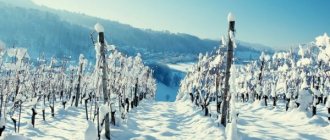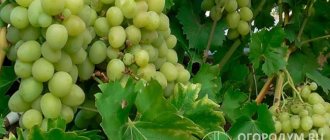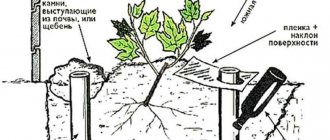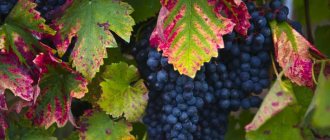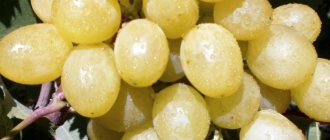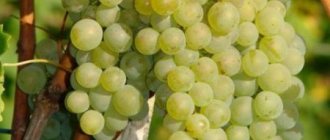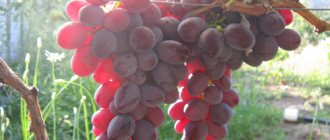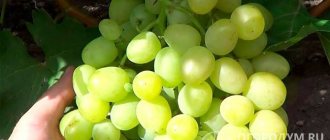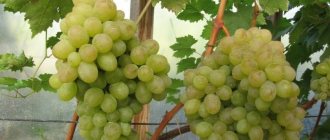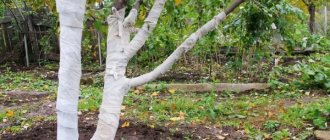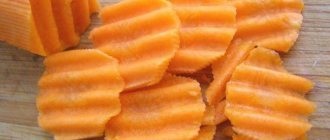Dessert grape varieties have moved far to the north: the Northwestern region, the Middle Urals, Siberia - thousands of kilometers from Central Asia and the foothills of the Caucasus, where grapes have been cultivated for centuries.
Small-fruited southerners, which have undergone acclimatization and are included in the register as new zoned grape varieties, thrive on trellises and arbors and produce quite a decent vine harvest.
Why do they cover grapes for the winter?
For gardeners from regions with a cool climate, it will seem strange that grapes are hidden in the south of Russia - Kuban. A relatively warm winter does not at all guarantee a successful wintering of the grapevine. Frequent thaws, weak snow cover, blowing winds - these factors are much more dangerous for a grape bush than frost of −20 °C with a snow layer thickness of 20-30 cm.
Central Asian varieties in our latitudes can only grow in greenhouses. Varieties traditional for the south of Russia can withstand:
- vine - minus 20-22 °C;
- root system - only minus 5-8 °C.
Grapes are a very flexible crop: they are easy to acclimatize. In case of damage to the above-ground part of the bush, it is restored within 2 years.
To preserve the vineyard, it is necessary to protect the roots from winter freezing, and to obtain a harvest next year, it is necessary to preserve the fruit buds on the vines and not freeze them. This problem is solved by covering the grapes for the winter.
Successful wintering of a bush requires high-quality ripening of the wood and proper preparation.
Additional factors
It should be noted that this division is quite conditional. Some varietal varieties can be classified as one or the other group. In addition, the success of wintering depends on the age of the wood (old ones will overwinter better), cold affects different parts of the plant differently. The roots are more vulnerable in this regard, as are the main buds in relation to the lateral and, especially, dormant buds.
Increases the chances of successful wintering and proximity to the walls of houses on the leeward side. Accordingly, plantings exposed to winds are in greater need of protection.
The “swampy-cloudy” climate, as, for example, in the Leningrad region, deserves a separate discussion. A short frost-free period, lack of sun and heat, especially at the end of the season - it is even more difficult to get a high-quality harvest here due to the process of lignification of the vine, which is difficult in these conditions, without which there may not be any berries at all. In this region, preference should be given to American selection of the “Isabelle” type.
Read more: Hungarian raisin grape variety
How to prepare grapes
Preparing a vineyard for shelter for the winter is a multi-stage process that includes a whole range of activities. You cannot ignore any item from the list:
- After removing the last bunch, you should start improving the health of the vineyard. Even if there are no obvious spots of mildew, the bunches have not been affected by oidium or gray rot, it is necessary to carry out preventive treatment against fungal diseases. The remedy for treatment or prevention is chosen depending on the condition of the vineyard.
- Before the leaves fall off, it is necessary to feed the vine with potassium, phosphorus, and microelements. Most fungal disease prevention products are compatible with liquid foliar fertilizers. Such mixtures even enhance each other’s effects.
- Under no circumstances should humus, compost or chemical nitrogen fertilizers be applied to the roots. The gardener’s task is to prepare the vineyard for winter “sleep”. Nitrogen fertilizing provokes growth processes that, on the eve of wintering, only harm the plant itself.
- Before covering the vines for the winter, it is necessary to water-charge the vineyard. This is the only case when excess water cannot interfere with an adult bush - you can do without such watering only in case of rainy autumn. Moisture-saturated soil freezes less and protects roots from freezing.
- Before laying in the shelter for the winter, the covering grape varieties are pruned. It is not advisable to rush into pruning: the vine must ripen well - there is an outflow of nutritious juices to the fruit vines and sleeves. Practice shows that even in the southern regions, grape leaves fall off after frost. This will be the signal to prune the vines for the winter.
After pruning, the vines are tied in bunches and pinned to the ground. After this, the final treatment against fungal diseases is carried out before sheltering for the winter.
Cultivation
Difficulties . It is relatively easy to grow, but a mature vine will require quite a bit of care.
Landing . Typically, greenhouse grapes are planted outside, in a bed adjacent to the wall of the greenhouse, where nothing restricts the roots and where they are nourished by rain moisture, and the above-ground part of the plant is covered in the greenhouse. But you can plant the vine in the greenhouse itself, on a wall bed, or in a large container with loamy compost. Apart from plants grown in pots, the vine requires a section of wall at least 2.5 m wide for support or a frame of wire stretched between posts.
Care . Water the plant well as spring approaches, increasing watering as the grapes grow and mature. During active growth, feed the vine weekly with liquid tomato fertilizer.
In the spring, to stimulate growth, scatter 25-50 g of universal fertilizer and 15-25 g of potassium sulfate on the soil near the base of the vine. If the vine is growing in a container, remove a few inches of topsoil and replace with fresh loam compost supplemented with a dry, slow-release fertilizer.
Wherever grapes grow, they need regular pruning. In winter, prune side shoots to the two large buds closest to the main shoot. If the grapes are growing in a pot, cut off the current year's growth, also leaving two large buds. In summer, shorten non-flowering side shoots to 5-6 leaves, and flowering ones to 2 leaves per inflorescence. Artificial pollination may be required.
Read also: The best grape variety
Thin the bunches to get a harvest of sweet and juicy berries. Even on mature plants, leave only 2-3 clusters on each side shoot, removing the rest at the flowering stage. When the fruits begin to develop, you can remove up to two-thirds of the berries from each bunch so that the remaining ones are filled properly - it’s painstaking work, but it’s worth it.
Cleaning . Wait until the berries are completely ripe. The harvested grapes do not ripen. Before harvesting, pick one berry from the bunch for testing to make sure the grapes are ripe.
Storage. Grapes can be stored in the refrigerator for 1-2 weeks. You can freeze it and eat it like sorbet or use it to make fruit smoothies.
How to properly cover grapes in the fall
Beginning gardeners often make the mistake of covering the grapes too early: they are afraid of being late with the covering, due to ignorance or due to lack of time. The reasons are different, but the result of such an error negates all previous efforts: with the slightest increase in the ambient temperature, fungal and rot spores awaken in the warmth and dampness of the shelter.
The grapes should be finally covered when stable average daily temperatures have been established slightly below 0, optimally - minus 2-5 °C.
After all the preparatory preventive treatments and pruning, the vine should be tied and pinned to the ground. It is necessary that everything is ready to shelter the grapes for the winter with zero temperatures established.
There is no need to worry about frost damage to the vine. The grape bush easily tolerates such temperatures. Modern large-fruited varieties of Russian selection are able to withstand Siberian frosts:
- raisins “Venus” up to -30 °C;
- raisins “Spartan” up to -35 °C;
- technical (wine) variety “Louise Swenson” up to -40 °C.
Against this background, the popular “Arcadia” and “Kodryanka” in the south of Russia seem “sissy” with their frost resistance down to −20-22 °C.
It would seem that with such indicators, grapes should grow to the Arctic Circle. The “weak link” of grapes is the root system, which, after proper preparation of the bush for wintering, can tolerate no more than 7-10. Without high-quality shelter for the root circle and weak snow cover, the grapes are doomed.
How to cover grapes - popular methods
Methods of covering vines depend on regional climate characteristics and differ in reliability and complexity.
The simplest from a technical point of view, but labor-intensive method, is digging the vines in with earth. Once prepared and processed, it is covered with boards and covered with a 20-30 cm layer of earth. The method is not applicable in regions with frequent thaws - melt water fills the pit and repeated freezing-thawing cycles are 100% likely to destroy the vine.
To reliably cover a grape bush, it is best to use the option of forming a protective air layer around the vine.
- The prepared vines are wrapped in lutrasil or other breathable material.
- The bundle is placed on boards, pinned to the ground using arcs, or fixed in any convenient way.
- Polyethylene film is laid on top of the vines on the arcs. Press its edges to the ground with bricks or boards.
For regions where snow falls in a layer of at least 30-50 cm in winter and does not have time to melt during the thaw, such shelter is quite sufficient. Fallen snow creates additional thermal insulation, and the grapes overwinter in comfortable conditions.
For regions with little snow winters, it is necessary to add 1 more layer of air space - install a box of wooden panels, slate sheets, etc. over the film shelter with a “hut” or in another way. Easy-to-manufacture wooden frames, upholstered, etc. are often used as such collapsible covering structures on both sides with roofing felt or roofing felt.
It is not recommended to immediately cover the grapes completely - tightly close all gaps in the structure until the average daily temperature reaches 5-7 °C. A slight frost will only benefit the vines - hardening increases the immunity of the grapes. When covering the bush on the sides in an area of easy access, vents should be left to regulate the temperature inside the bush in the event of a thaw.
When the temperature drops below − 5-7 °C (critical for the root system), the bush’s shelter should be closed from access to frosty air.
Care should be taken in advance to protect the ground from freezing. For owners of garden plots, the problem is solved very simply - fallen leaves are poured on the sides of the shelter.
Covering material for grapes
The choice of material for covering a grapevine for the winter depends on many factors, the main of which are:
- variety of grapes grown;
- condition and age of the vine;
- climatic zone where grapes grow;
- availability of available materials, etc.
There are 2 basic principles for covering grapes in the fall - wet and dry. In practice, a combination of these methods is often used.
Method of covering vines with soil
The method is based on the laws of physics.
- Soil saturated with moisture-recharging autumn watering has a much greater heat capacity compared to its dry state. Wet soil does not freeze so quickly, which preserves the root system of the bush.
- A layer of soil poured over the laid vines behaves similarly. To the effect of increasing the heat capacity of the soil is added the thermal insulating contribution of the embankment.
A technically simple method of protecting vines has disadvantages:
- the process is labor-intensive; digging ditches and moving soil is hard work;
- in the event of a thaw, the vine is flooded, which leads to its death;
- A bush covered with earth is not easy to remove from the embankment in early spring.
Typically, winegrowers do not use this method in its “pure” form.
"Dry" methods
Dry air is an almost perfect heat insulator. The formation of air space around the vine is the basis of all variants of the “dry” method. To cover the grapes, non-woven synthetic and improvised materials are used.
| A type of synthetic covering material | Characteristic | Advantages | Flaws |
| PE film | Used mainly as additional protection against precipitation | Inexpensive protective material | Does not allow air to pass through |
| Agrofibre, spunbond, lutrasil | There is no fundamental difference between these materials - they differ in density | Reusable, inexpensive, easy-to-use material with high breathability | They allow water to pass through - additional protection from precipitation is required. |
Most often in practice, winegrowers use a combination of nonwoven materials with PE film.
If you have straw, reeds, and spruce branches, organizing a winter shelter for the vines is even easier. The prepared vines are laid on a layer of the listed materials and covered with another layer of thermal protection. An obligatory step is to cover everything with a waterproof covering material, for example, PE film.
To create a reliable shelter, add additional protection from slate sheets. This measure is especially necessary in open areas exposed to winds.
Disinfection of covering material
All fabric materials used to cover the grapes must be thoroughly dried in the spring and special anti-fungal agents applied to them. After this, they are placed in a dry room or under a canopy. Check the material occasionally to prevent moisture from getting on it.
By the time you cover the grapes, you need to stock up on herbs such as wormwood, tansy, marigolds, and calendula to repel pests from the material. Bunches of these herbs are covered with dry leaves or straw. If there are rodents in the garden, you can set bait with poison or sprinkle with dust.
Shelter materials are selected not only based on their availability and individual preference, but also on their climatic conditions. For example, in certain regions you should not use film, especially placing it directly on the vine - this will lead to the death of the buds. In places with wet winters, covering with a soil substrate can protect against frost, but can lead to rot. So, the following covering materials differ.
- Earth and humus.
- Snow.
- Sawdust (according to experienced winegrowers can be considered exclusively as an element of a combined shelter, but not as an independent material).
- Straw.
- Coniferous spruce branches and just pine needles.
- Polyethylene film.
- Agrofibre and other industrial materials specially produced for these purposes.
Read the article on the topic: The best covering material for beds. From frosts, pests, weeds. Overview of covering materials
The choice of covering material depends on the standard temperature and amount of precipitation. The important characteristics of the material will be:
- density;
- waterproof;
- breathability.
Hilling up with soil
For protection in the form of an earthen mound above the bush, you need to use loose, preferably sandy, soil. Under the clay soil around the vines, moisture accumulates, the freezing of which damages the wood, and in the spring the heavy soil slowly warms up, making it impossible to remove the cover in time.
The soil for hilling must be dry and should be prepared in advance. Often soil is taken from between the rows, but this is unsafe if the grape bush is not young and tall - the roots reaching this area may freeze.
Before hilling, the vine must be placed in a trench. If severe frosts are expected, a layer of fallen leaves or straw should be made in the soil. The thickness of each layer is 15 cm, their number depends on the required thermal insulation, but the top layer should be soil. The total thickness of the covering layer can vary from 15 to 50 cm. The diameter of the embankment must correspond to the size of the root system, the minimum figure is 30 cm (for annual grapes).
Read more: Blockage and inflammation of goiter in chickens, symptoms, treatment of the disease
Mulch
For winter shelter, the mulch should be light and loose. In all cases, it is preferable to place the vines on the flooring; otherwise, each material has its own installation requirements:
- Coniferous branches. The best option for grapes is spruce branches that do not interfere with air circulation and retain snow. Substances contained in pine or spruce branches repel rodents and prevent the development of fungi and mold under cover. The layer thickness should be about 30-40 cm.
- Straw. It is recommended to place in 2 batches as frosts intensify. A layer of 40 cm is required. The straw needs to be secured on top - sprinkled with snow or covered with spunbond, otherwise the mulch will be blown away by the wind. Reed can replace straw.
- Wood leaves. The material should be dry, but fallen leaves should be dried immediately after collection, and not before laying. The mulching method is similar to covering with straw.
- Sawdust. They are distinguished by high thermal insulation qualities, but they easily become damp and retain moisture for a long time, so they can only be used within the dry method. Several layers of film should be placed under the vine, and after mulching, shields made of slate or wood should be installed over the bush.
Snow protection
It is not necessary to place any additional layer between the bush and the snow. If there is enough snow and there is no risk of a thaw, you can put it directly on the branches in a layer of 40-50 cm.
Attention!
The method is contraindicated for seedlings - the plants are not properly hardened and may die.
The snowdrift above the bush should be lightly compacted so that the wind does not destroy it. It is recommended to lay the vines under such “mulch” on the flooring.
Slate or plywood
The materials are used as shields as part of the dry shelter method. In this case, the soil under the vine should be covered with film, and the bush should be covered with a layer of leaves or straw on top. Above the grapes you need to install sheets of slate or plywood in the form of a pitched roof. The joints between the panels must be covered with waterproof material (film, roofing felt), sprinkled with soil to secure them. Shields can be insulated by placing burlap, paper, and cardboard boxes on top of them, which need to be covered with layers of leaves and soil.
You may be interested in:
In rare cases, synthetic covering materials can be used as self-sufficient protection for grapes; more often they are combined with mulch, an earthen mound or shields.
- Agrofibre. Without additional insulation, the material can only be used in the southern regions. In this case, it is allowed to cover or wrap the vines without removing them from the trellis. Colder winters or alternating thaws and drops in temperature will require increased cover with a layer of mulch. Spunbond allows moisture to pass through, so you need to put a flooring under the vine.
- Ruberoid. Suitable for covering grape bushes growing in warm but snowless winters. The vines need to be placed in the grooves and covered with roofing felt on top. The material is impermeable to water and air; it is necessary to leave gaps for ventilation. When frosts intensify without snow, a layer of mulch should be placed on top of the roofing material.
- Film. The material is used when it is important to prevent precipitation from getting on the vine. But the film will not protect against frost; it can only be used as an additional cover, for example, together with mulch. The shelter is made like a greenhouse - the material must be stretched over arches installed above the bush. The edges of the film should be sprinkled with soil, leaving a gap on one side for air circulation. It is important that there is a layer of air between the film and the vine - areas that touch the thin cover will freeze.
- Polymer film. One of the serious disadvantages of covering with film is the formation of condensation on the inner surface of the material. Because of this, the bushes are likely to be damaged by fungi and rot. But if you use a high-density polymer film with reflective properties, there will be no problem with moisture.
Young bushes - features of shelter for 1-2 year olds
Young plantings of grapes are much more sensitive to low temperatures and dry winds - it will take 2-3 years to form a sleeve with a supply of sugars and water for the winter. Without reliable shelter, a young bush will not survive even a mild winter.
The absence of hard perennial wood is a big “plus” when organizing a winter shelter for a young bush.
- After all treatments, the vine is rolled into a ring.
- A box without a bottom (a bucket without a bottom, etc.) is “put on” the bush.
- The space inside the box (other container) is filled with sawdust, straw, dry leaves, etc.
- The box is covered with a lid.
- An additional layer of straw, leaves, etc. should be poured on the sides of the box to protect the soil from freezing.
- Cover the entire structure with thick PE film. Press the film with bricks or boards.
In the snowy regions of Siberia and the Urals, gardeners add an additional layer of snow to guarantee wintering of the grape “youth”.
The video shows one of the ways to cover grapes, in which the plant can withstand severe frosts.
Grapes in a greenhouse - how to close
Growing grapes in a greenhouse is justified not only for regions with extreme climates. The North-West and Belarus are not the best climatic zones for harvesting outdoors. The grape bush is so sensitive to excess moisture that even in the south they try to plant it under light shelter from the rain.
Theoretically, there is no point in being particularly zealous in covering the grapes with protected soil. Experience shows that in winter any surprises are possible. It is better to take precautions and cover the grapes for winter. Perform the standard sequence of operations:
- The vines are processed, pruned and tied into bunches.
- The grape trunk circle is covered with a layer of leaves, sawdust, spruce branches; bent to the ground and pinned with arcs.
- PE film is placed over the arcs.
- The edges of the film are pressed with bricks or boards.
Caring for – caring for grapes grown in a greenhouse
We are very careful about the use of nitrogen fertilizers.
When the buds open, at the beginning of growth, water the vines with a solution of ammonium nitrate (10 g per 10 liters of water) 3 times with an interval of 1 week. Then, before flowering begins, we add superphosphate (15 g per bucket of water) and give foliar fertilizing with Uniflor-Wooton fertilizer (but instructions), which we also combine in tank mixtures with antistress agents. You can carry out foliar feeding during the budding period with preparations such as “Ovary” or “Bud”.
When the vines bloom, stop watering and ventilate the greenhouse. In wet, cold weather, we carefully control pollination conditions.
After flowering, we continue to add superphosphate (15 g per bucket of water) and wood ash (1 tbsp per bucket of water) until the berries stop growing. During the period of filling the berries, we stop watering.
During this period, the air humidity in the greenhouse increases, and this leads to cracking of the berries and the spread of gray rot. Air humidity is regulated by ventilation during the day in good weather, but in cloudy weather and at night we close the greenhouse. Varieties with a loose cluster and dense skin of the berries are less susceptible to cracking and usually produce ripe berries in late August - mid-September.
Read also: Middle Urals grapes
What you need to know about uncovered grape varieties
Uncovered varieties are a relative concept. For the south of Russia, “Preobrazhenie” and “Agat Donskoy” are non-covering varieties, but not for the Central region and more northern territories.
If non-covering varieties do not require serious shelter for the winter, this does not mean that preparation for winter is not required. Preparatory operations are carried out in the same way after harvesting.
- Treatment with antifungal drugs according to a prophylactic or treatment regimen, depending on the condition of the bushes.
- Moisture-charging irrigation.
- Pre-pruning of the vine. Unlike covering varieties, final formative pruning is not carried out on grapes overwintering without shelter: only fruit-bearing vines and parts of the bush with obvious damage are removed.
- Instead of covering the entire bush, for cold-resistant varieties, cover the trunk circle with foliage, sawdust, or any mulching material.
The final pruning, taking into account the load on the vine, is carried out in the spring, after the start of sap flow.
Protecting grapes sheltered for the winter from diseases
It is important not only to properly cover the plant for the winter, but to protect it from diseases. From the time of budding, it is worth starting preventive spraying with special low-toxic agents. Among them are:
- "Lugol" or potassium iodide approximately 0.02%;
- Baking soda in the amount of 0.8%;
- Potassium permanganate is suitable, approximately 0.3%.
It is worth adding the necessary fertilizers and microelements to the sprayer. They significantly enhance the plant’s defenses, especially if special agents are added to the general solution aimed at treating diseases and protecting against pests.
If the vine is formed correctly as a result of care, a large number of fruitful ones will certainly appear among the numerous shoots. It is very easy and simple to identify them; they will be indicated by the rudiments of inflorescences located at the bottom of numerous shoots. All non-fruitful shoots are removed while still in a non-lignified state. If the grapes have no fruitful branches and shoots at all, we can judge that the variety is completely unsuitable. It is believed that grapes with dark berries require much more heat to fully ripen. This information will be a useful guide in the process of choosing the right variety.
